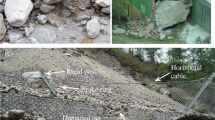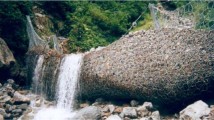Abstract
Flexible ring nets exhibit complex nonlinear mechanical behaviour when subjected to static and dynamic impact loads. This research presents the development of an efficient numerical model for assessing the performance of flexible netting barriers used in debris flow and rockfall risk mitigation. The model is calibrated through benchmark analyses and based on the equivalent stiffness method. The results demonstrate that the proposed numerical approach offers a significant computational cost reduction of 80% compared to complex numerical models while maintaining high accuracy. The coupled Eulerian–Lagrangian finite element method (CEL) is employed to simulate fluid–debris–structure interaction, showing damage characteristics consistent with flexible ring net barriers. The model is suitable for accurately determining the impact forces acting on the barrier and presents the debris behaviour and movement at various flow velocities. Notably, the results confirm that the presented model is capable of evaluating the interaction between the flexible barrier and debris flow with boulders and is an efficient approach to estimating the performance of flexible protection subjected to impacts.

























Similar content being viewed by others
References
Petley D (2012) Global patterns of loss of life from landslides. Geology. https://doi.org/10.1130/G33217.1
Pachauri RK, Allen MR, Barros VR, Broome J, Cramer W, Christ R, Church J A, Clarke L, Dahe Q, Dasgupta P (2014) Climate change 2014: synthesis report. Contribution of Working Groups I, II and III to the fifth assessment report of the Intergovernmental Panel on Climate Change. IPCC. https://www.ipcc.ch/report/ar5/syr/
Tang H, Xia C, Wang K, Jiang J, Xia H (2022) Reliability-based vulnerability analysis of bridge pier subjected to debris flow impact. Struct Infrastruct Eng. https://doi.org/10.1080/15732479.2022.2074468
VanDine D (1996) Debris flow control structures for forest engineering. In: Res. Br., BC Min. For., Victoria, BC, Work. Pap, vol 8
Jakob M (2005) Debris-flow hazard analysis. In: Debris-flow hazards and related phenomena. Springer, pp 411–443 https://doi.org/10.1007/3-540-27129-5_17
Piton G, Recking A (2016) Design of sediment traps with open check dams. I: hydraulic and deposition processes. J Hydraul Eng. https://doi.org/10.1061/(ASCE)HY.1943-7900.0001048
Leonardi A, Pirulli M (2020) Analysis of the load exerted by debris flows on filter barriers: comparison between numerical results and field measurements. Comput Geotech. https://doi.org/10.1016/j.compgeo.2019.103311
Takahashi T (2007) Debris flow: mechanics, prediction and countermeasures. Taylor & Francis. https://doi.org/10.1201/9780203946282
Cortes Arevalo VJ, Sterlacchini S, Bogaard TA, Junier S, van de Giesen N (2016) Decision support method to systematically evaluate first-level inspections of the functional status of check dams. Struct Infrastruct Eng. https://doi.org/10.1080/15732479.2016.1144619
Suda J, Strauss A, Rudolf-Miklau F, Hübl J (2009) Safety assessment of barrier structures. Struct Infrastruct Eng. https://doi.org/10.1080/15732470701189498
Mizuyama T (2008) Structural countermeasures for debris flow disasters. Int J Eros Control Eng. https://doi.org/10.13101/ijece.1.38
Armanini A (1997) On the dynamic impact of debris flows. In: Recent developments on debris flows. Springer, pp 208–226. https://doi.org/10.1007/BFb0117770
Yu Z, Liu C, Guo L, Zhao L, Zhao S (2019) Nonlinear numerical modeling of the wire-ring net for flexible barriers. Shock Vib. https://doi.org/10.1155/2019/3040213
Thoeni K, Lambert C, Giacomini A, Sloan SW (2013) Discrete modelling of hexagonal wire meshes with a stochastically distorted contact model. Comput Geotech. https://doi.org/10.1016/j.compgeo.2012.10.014
Bertrand D, Trad A, Limam A, Silvani C (2012) Full-scale dynamic analysis of an innovative rockfall fence under impact using the discrete element method: from the local scale to the structure scale. Rock Mech Rock Eng. https://doi.org/10.1007/s00603-012-0222-5
Frenez T, Roth A, Kaestli A (2004) Debris flow mitigation by means of flexible barriers. In: Proceedings of the 10th congress interpraevent. https://doi.org/10.5194/nhess-12-1693-2012
Fonseca RL, Quintana CR, Megal LL, Roth A (2007) Protection systems against debris flows. WIT Trans Built Environ. https://doi.org/10.2495/SAFE070081
Wendeler C, Volkwein A, Roth A, Denk M, Wartmann S (2007) Field measurements and numerical modelling of flexible debris flow barriers. In: Debris-flow hazards Mitig. Mech. Predict. Assess. Millpress, Rotterdam. https://www.dora.lib4ri.ch/wsl/islandora/object/wsl:11851
Volkwein A (2005) Numerical simulation of flexible rockfall protection systems. In: Computing in civil engineering, pp 1–11 https://doi.org/10.1061/40794(179)122
Vagnon F, Segalini A (2016) Debris flow impact estimation on a rigid barrier. Nat Hazards Earth Syst Sci. https://doi.org/10.5194/nhess-16-1691-2016
Zhao L, He JW, Yu ZX, Liu YP, Zhou ZH, Chan SL (2020) Coupled numerical simulation of a flexible barrier impacted by debris flow with boulders in front. Landslides. https://doi.org/10.1007/s10346-020-01463-x
Escallón J, Wendeler C (2013) Numerical simulations of quasi-static and rockfall impact tests of ultra-high strength steel wire-ring nets using Abaqus/Explicit 2013 SIMULIA Community conference, https://www.3ds.com/fileadmin/PRODUCTS/SIMULIA/PDF/scc-papers
Trad A, Limam A, Bertrand D, Robit P (2013) Multi-scale analysis of an innovative flexible rockfall barrier. Rockfall Eng. https://doi.org/10.1002/9781118601532.ch9
Gentilini C, Govoni L, de Miranda S, Gottardi G, Ubertini F (2012) Three-dimensional numerical modelling of falling rock protection barriers. Comput Geotech. https://doi.org/10.1016/j.compgeo.2012.03.011
Van Tran P, Maegawa K, Fukada S (2013) Prototype of a wire-rope rockfall protective fence developed with three-dimensional numerical modeling. Comput Geotech. https://doi.org/10.1016/j.compgeo.2013.06.008
Huang Y, Yiu J, Pappin J, Sturt R, Kwan JS, Ho KK (2014) Numerical investigation of landslide mobility and debris-resistant flexible barrier with LS-DYNA. In: Proceedings of the 13th international LS-DYNA users conference
Nicot F, Cambou B, Mazzoleni G (2001) Design of rockfall restraining nets from a discrete element modelling. Rock Mech Rock Eng. https://doi.org/10.1007/s006030170017
Escallón JP, Wendeler C, Chatzi E, Bartelt P (2014) Parameter identification of rockfall protection barrier components through an inverse formulation. Eng Struct. https://doi.org/10.1016/j.engstruct.2014.07.019
Tahmasbi S, Giacomini A, Wendeler C, Buzzi O (2019) On the computational efficiency of the hybrid approach in numerical simulation of rockall flexible chain-link mesh. Rock Mech Rock Eng. https://doi.org/10.1007/s00603-019-01795-8
Wendeler C (2016) Debris-flow protection systems for mountain torrents—basic principles for planning and calculation of flexible barriers. Swiss Federal Institute for Forest, Snow and Landscape Research WSL. www.wsl.ch/publikationen/pdf/15501.pdf
Sautter KB, Hofmann H, Wendeler C, Wilson P, Bucher P, Bletzinger K-U, Wüchner R (2021) Advanced modeling and simulation of rockfall Attenuator barriers via partitioned DEM-FEM coupling. Front Built Environ. https://doi.org/10.3389/fbuil.2021.659382
Crosta G, Imposimato S, Roddeman D (2009) Numerical modelling of entrainment/deposition in rock and debris-avalanches. Eng Geol. https://doi.org/10.1016/j.enggeo.2008.10.004
Lin CH, Hung C, Hsu TY (2020) Investigations of granular material behaviors using coupled Eulerian-Lagrangian technique: From granular collapse to fluid-structure interaction. Comput Geotech. https://doi.org/10.1016/j.compgeo.2020.103485
Qiu G, Henke S, Grabe J (2011) Application of a coupled Eulerian-Lagrangian approach on geomechanical problems involving large deformations. Comput Geotech. https://doi.org/10.1016/j.compgeo.2010.09.002
Documentation A (2014) Abaqus Analysis User’s Guide, Version 6.14. Dassault Systemes Simulia Corp., Providence
Chen HX, Li J, Feng SJ, Gao HY, Zhang DM (2019) Simulation of interactions between debris flow and check dams on three-dimensional terrain. Eng Geol. https://doi.org/10.1016/j.enggeo.2019.02.001
Imran J, Harff P, Parker G (2001) A numerical model of submarine debris flow with graphical user interface. Comput Geosci. https://doi.org/10.1016/S0098-3004(00)00124-2
Jeong SW, Locat J, Leroueil S, Malet J-P (2010) Rheological properties of fine-grained sediment: the roles of texture and mineralogy. Can Geotech J. https://doi.org/10.1139/T10-012
Kaitna R, Rickenmann D, Schatzmann M (2007) Experimental study on rheologic behaviour of debris flow material. Acta Geotech. https://doi.org/10.1007/s11440-007-0026-z
Sha SY, Dyson AP, Kefayati G, Tolooiyan A (2023) Simulation of debris flow-barrier interaction using the smoothed particle hydrodynamics and coupled Eulerian Lagrangian methods. Finite Elem Anal Des. https://doi.org/10.1016/j.finel.2022.103864
Leonardi A, Wittel FK, Mendoza M, Vetter R, Herrmann HJ (2016) Particle–fluid–structure interaction for debris flow impact on flexible barriers. Compu Aided Civ Infrastruct Eng. https://doi.org/10.1111/mice.12165
Dai ZL, Huang Y, Cheng HL, Xu Q (2017) SPH model for fluid–structure interaction and its application to debris flow impact estimation. Landslides. https://doi.org/10.1007/s10346-016-0777-4
Ciurleo M, Mandaglio MC, Moraci N (2021) A quantitative approach for debris flow inception and propagation analysis in the lead up to risk management. Landslides. https://doi.org/10.1007/s10346-021-01630-8
European Commitee for Standardization (2002) EN 10264-2: steel wire and wire products—steel wire for ropes—part 2: cold drawn non alloy steel wire for ropes for general applications
Kwan JS, Chan SL, Cheuk JC, Koo R (2014) A case study on an open hillside landslide impacting on a flexible rockfall barrier at Jordan Valley. Landslides, Hong Kong. https://doi.org/10.1007/s10346-013-0461-x
Sasiharan N, Muhunthan B, Badger T, Shu S, Carradine D (2006) Numerical analysis of the performance of wire mesh and cable net rockfall protection systems. Eng Geol. https://doi.org/10.1016/j.enggeo.2006.09.005
Dhakal S, Bhandary N, Yatabe R, Kinoshita N (2011) Experimental, numerical and analytical modelling of a newly developed rockfall protective cable-net structure. Nat Hazards Earth Syst Sci. https://doi.org/10.5194/nhess-11-3197-2011
Mentani A, Govoni L, Giacomini A, Gottardi G, Buzzi O (2018) An equivalent continuum approach to efficiently model the response of steel wire meshes to rockfall impacts. Rock Mech Rock Eng. https://doi.org/10.1007/s00603-018-1490-5
Geobrugg AG (2016) Product manual VX/UX debris flow barriers. https://www.geobrugg.com/
Li X, Zhao J, Kwan JS (2020) Assessing debris flow impact on flexible ring net barrier: a coupled CFD-DEM study. Comput Geotech. https://doi.org/10.1016/j.compgeo.2020.103850
Zhang Y, Qin Y, Zhu Y, Shi J, Huo W (2022) Numerical and analytical studies of flexural behaviour of prestressed UHPC joints. Struct Infrastruct Eng. https://doi.org/10.1080/15732479.2022.2082493
Martinez CE (2009) Eulerian-Lagrangian two phase debris flow model. https://doi.org/10.25148/etd.FI09121601
Persi E, Petaccia G, Sibilla S (2018) Large wood transport modelling by a coupled Eulerian-Lagrangian approach. Nat Hazards. https://doi.org/10.1007/s11069-017-2891-6
Persi E, Petaccia G, Sibilla S, Lucía A, Andreoli A, Comiti F (2020) Numerical modelling of uncongested wood transport in the Rienz river. Environ Fluid Mech. https://doi.org/10.1007/s10652-019-09707-8
Acknowledgements
Financial support for this research has been provided by Natural Disaster Risk Reduction Grants Program (NDRRGP) as part of the Australian Government National Disaster Risk Reduction Framework (NDRRF) and the Tasmanian Government Disaster Resilience Strategy, in partnership with the Tasmanian State Emergency Services (TSES). The grant's title is “Mount Wellington Debris Flow Risk Reduction and Mitigation Strategies”. The first author is funded by the Australian Government Research Training Program (RTP).
Author information
Authors and Affiliations
Corresponding author
Ethics declarations
Conflict of interest
The authors declare that they have no known competing financial interests or personal relationships that could have appeared to influence the work reported in this paper. The authors declare the following financial interests/personal relationships which may be considered as potential competing interests:
Rights and permissions
Springer Nature or its licensor (e.g. a society or other partner) holds exclusive rights to this article under a publishing agreement with the author(s) or other rightsholder(s); author self-archiving of the accepted manuscript version of this article is solely governed by the terms of such publishing agreement and applicable law.
About this article
Cite this article
Sha, S., Dyson, A.P., Kefayati, G. et al. An Equivalent Stiffness Flexible Barrier for Protection Against Boulders Transported by Debris Flow. Int J Civ Eng 22, 705–722 (2024). https://doi.org/10.1007/s40999-023-00914-5
Received:
Revised:
Accepted:
Published:
Issue Date:
DOI: https://doi.org/10.1007/s40999-023-00914-5




